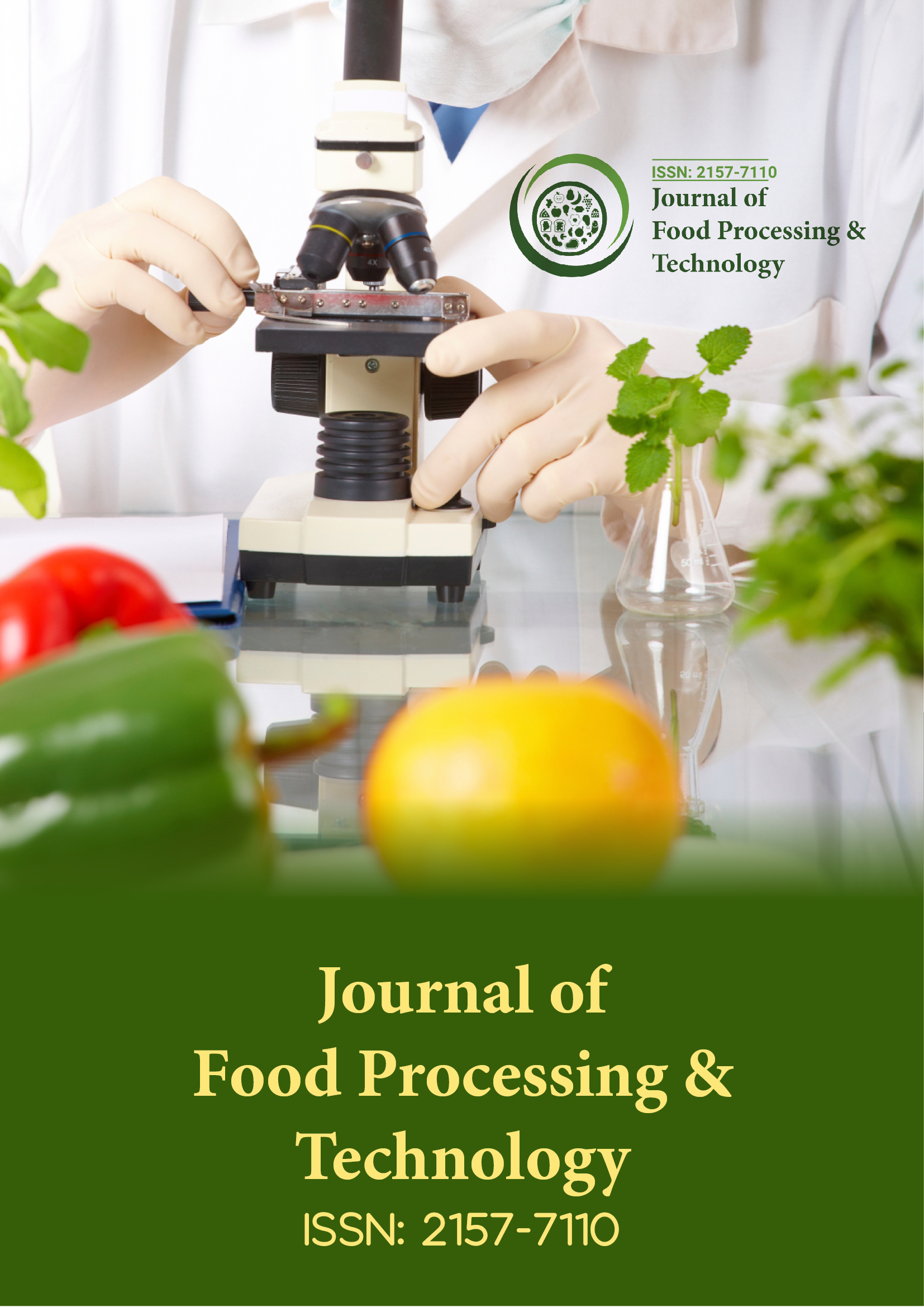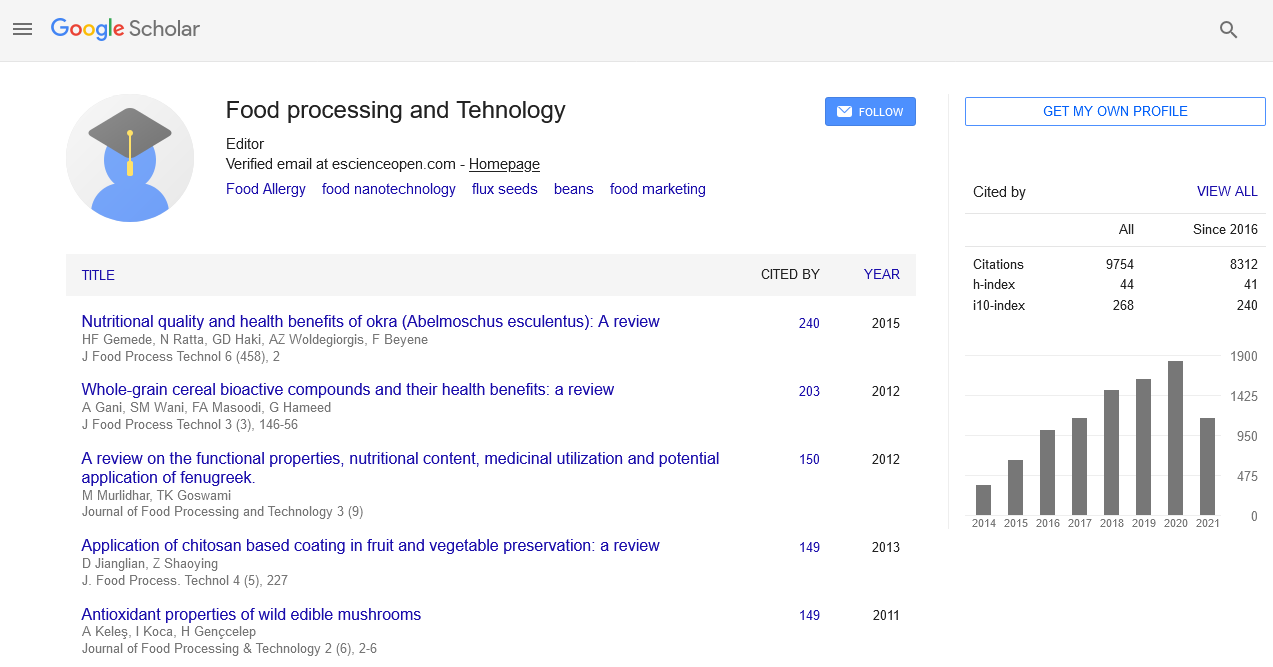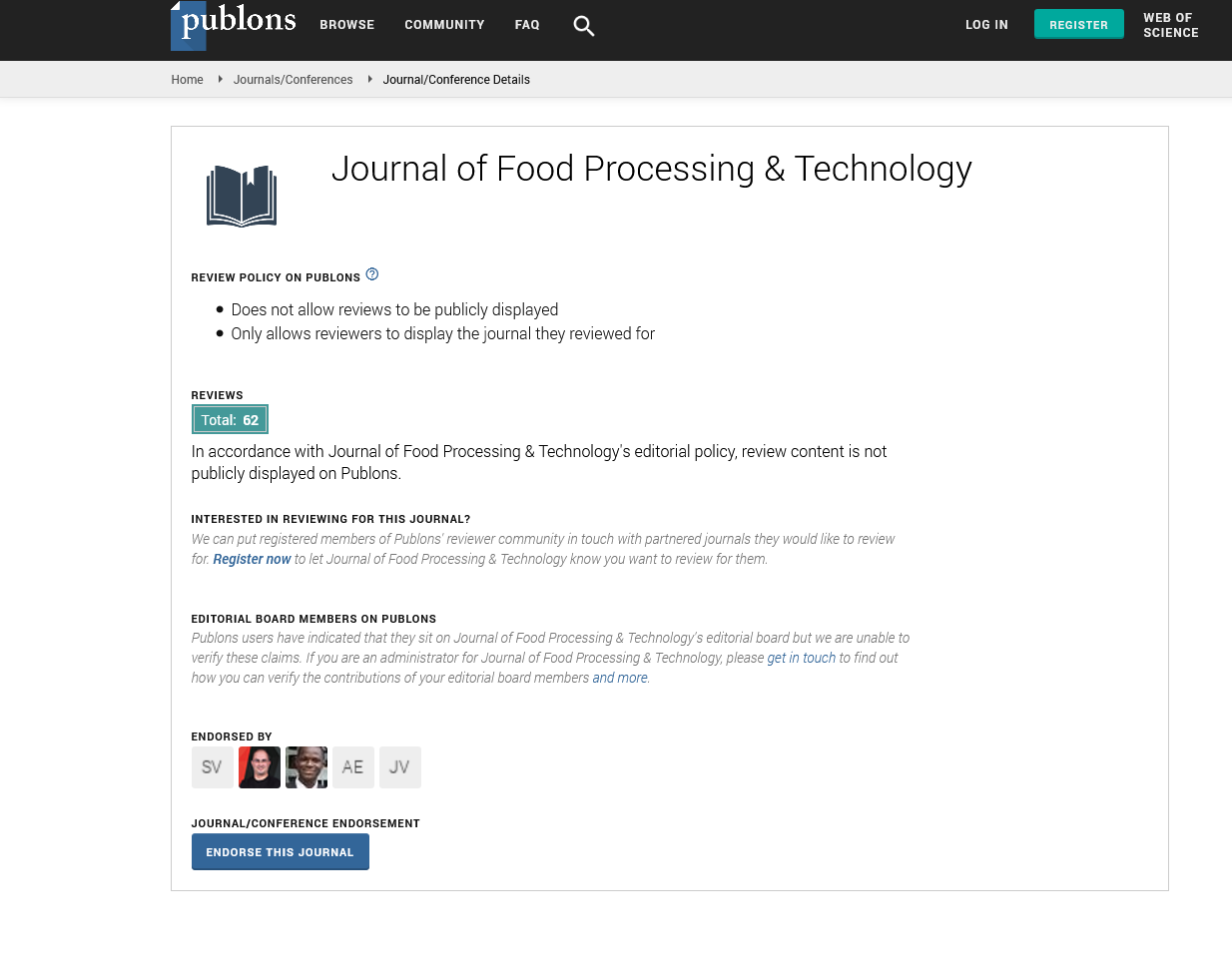Indexed In
- Genamics JournalSeek
- Academic Keys
- JournalTOCs
- China National Knowledge Infrastructure (CNKI)
- Access to Global Online Research in Agriculture (AGORA)
- Centre for Agriculture and Biosciences International (CABI)
- RefSeek
- Directory of Research Journal Indexing (DRJI)
- Hamdard University
- EBSCO A-Z
- OCLC- WorldCat
- Scholarsteer
- SWB online catalog
- Publons
- Euro Pub
- Google Scholar
Useful Links
Share This Page
Journal Flyer

Open Access Journals
- Agri and Aquaculture
- Biochemistry
- Bioinformatics & Systems Biology
- Business & Management
- Chemistry
- Clinical Sciences
- Engineering
- Food & Nutrition
- General Science
- Genetics & Molecular Biology
- Immunology & Microbiology
- Medical Sciences
- Neuroscience & Psychology
- Nursing & Health Care
- Pharmaceutical Sciences
Perspective - (2023) Volume 14, Issue 6
Innovative Food Preservation Techniques in Non-Thermal Processing Technologies
Odongo Ding*Received: 01-Jun-2023, Manuscript No. JFPT-23-22138; Editor assigned: 05-Jun-2023, Pre QC No. JFPT-23-22138 (PQ); Reviewed: 19-Jun-2023, QC No. JFPT-23-22138; Revised: 26-Jun-2023, Manuscript No. JFPT-23-22138 (R); Published: 03-Jul-2023, DOI: 10.35248/2157-7110.23.14.1029
Description
Non-thermal processing is a method of food preservation that utilizes non-thermal technologies such as high pressure, pulsed electric fields, ultrasound, and ultraviolet light to extend shelf life and enhance food safety. These processes are used in the food industry to destroy microorganisms, reduce spoilage, and improve quality without compromising sensory attributes or nutrition. Non-thermal processing has several advantages over traditional thermal processing.
These methods can be used to reduce the risk of contamination while preserving flavor, texture, color, and nutritional value of the food products. Non-thermal processes are also more energy efficient than thermal processes as they require less time and lower temperatures. Non-thermal processing also offers enhanced shelf life benefits compared to traditional thermal processing methods. By reducing microbial growth, these methods can extend the shelf life of many food products by several weeks or months depending on the type of product being processed. This allows manufacturers to provide consumers with fresher products with extended shelf life.
In addition to extending shelf life and enhancing food safety, non-thermal processing also offers environmental benefits as it uses less energy than traditional thermal treatments. This helps reduce greenhouse gas emissions associated with food production while still providing safe and high quality foods for consumers. Non-thermal processing is an effective method of preserving foods while extending shelf life and enhancing food safety without sacrificing taste or nutritional content of the product. It is a high-quality for manufacture considering for ways to produce safe foods quickly while minimizing their environmental impacts.
Non-thermal processing technologies are becoming increasingly popular as a means of extending shelf life and enhancing food safety. These technologies use physical, chemical and biological treatments to preserve food without the need for heat. This eliminates the risk of thermal damage to sensitive components, while also preserving the nutritional properties and sensory characteristics of the food. Some common types of non-thermal processing technologies include High Pressure Processing (HPP), Pulsed Electric Fields (PEF), Ultraviolet (UV) light, ozone treatment, High Intensity Pulsed Light (HIPL) and irradiation.
To eliminate germs and increase the shelf life of food, high pressure processing involves preserving it in an atmosphere with a very high pressure. Pulsed Electric Fields (PEF) is used to damage the cell walls of bacteria in food, representation them inert and preventing from reproducing. Shortwave radiation is used in both ultraviolet light and ozone treatment. Irradiation is a non-thermal processing method involving the use of gamma or electron radiation.
Advantage and disadvantages of non-thermal processing
Non-thermal processing is an important technology in the food industry which helps to preserve food products and enhance their safety. This type of processing is particularly useful for sensitive products, such as fruits, vegetables, dairy, and seafood. Non-thermal processing can extend shelf life while preserving the quality of the product. However, there are some advantages and disadvantages associated with this technology.
• One of the main advantages of non-thermal processing is that it helps to extend shelf life without sacrificing product quality. This means that food products can stay fresher for longer periods of time without losing their nutritional value or flavor. Non-thermal processing can help to reduce the risk of contamination by eliminating or reducing the number of pathogens present in food products.
• One of the main disadvantages is that this type of processing is more expensive than traditional thermal processes due to higher equipment costs and more complex processes involved. Non-thermal processes may not be as effective at destroy microorganisms as thermal processes are, so there is still a risk for contamination even after using this technology.
Citation: Ding O (2023) Innovative Food Preservation Techniques in Non-Thermal Processing Technologies. J Food Process Technol. 14:1029.
Copyright: © 2023 Ding O. This is an open access article distributed under the terms of the Creative Commons Attribution License, which permits unrestricted use, distribution, and reproduction in any medium, provided the original author and source are credited.


